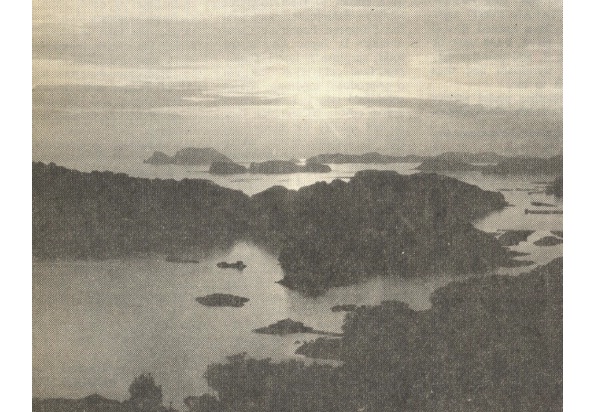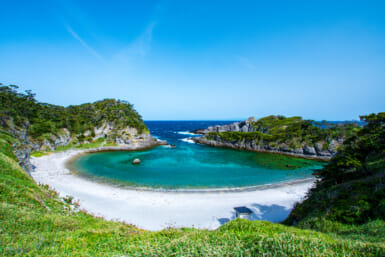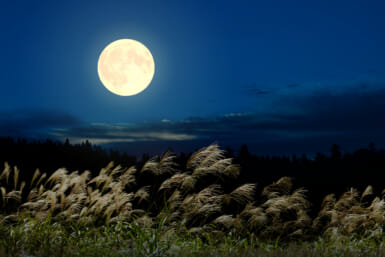by Alex Dean
“One hundred islands of rock on the bay. One hundred islands of rock. Take them out and pass sake about and there’s 99 islands of rock on the bay.”
Once upon a time — a long, long time ago, even way before the famous samurai swords took their toll through the Japanese countryside, even before Tanuki fell desperately in love with his beautiful princess — but not nearly as desperately as he loved his sake — and even before the ripening and bursting of the peach — there were 100 islands off the coast of Sasebo. The fall was always glorious, all 100 shimmering darkly under the dramatic oranges and reds of sunset. The fall — the time of last flings prior to the coming of white, the celebration of all good things now temporarily interrupted with cool sleep.
All hail! A party to celebrate the fall! The quiet village of Sasebo invites all 100 to the party of parties. And the islands all come, dragging dripping tendrils of rock to the very outskirts of the city. Sake for all! Flowing through their crags, into their mire, assuaging the thirst of their sub-tropical foliage, glistening on their sentinel rocks. Sake aplenty for all, late into the night!
And then as in all parties, the parting. Each island breaks off the festivities, sake-laden, and slowly transits out to their appointed spot in Sasebo Bay. Only when the sun rises there is one tiny little partier sound asleep within the city bounds. A small island, maybe 100 feet in length and 35 feet in width, maybe not so big. A bright, pre-winter sunray gently breaks into his consciousness; the youngster makes a valiant effort to return to his own special little spot in the Sasebo Bay. Alas! Too much sake or too small an island. His leap plops him one nautical mile outward and there he sinks back into his heavy slumber. And there little “ichi-ri jima” sleeps still, just outside Sasebo Naval Base.
So there are “99 islands of rock on the bay, 99 islands of rock.”
Only there aren’t really 99.
In 1570 the Portuguese arrived interrupting the tranquility of the fishing and farming community and birthing Sasebo commerce. But it wasn’t until 1883 that Sasebo began earning its place in history. The area was chosen by the Emperor (upon the recommendation of the then-Lt. Commander Togo) as the location for development of a naval base. In 1889 inauguration ceremonies were actually presided over by His Majesty the Emperor Meiji, an “event unparalleled in Sasebo’s memory.” Through the ensuing years Sasebo, primarily due to its location, became one of the largest Japanese naval bases.
“One hundred and twenty-three…” The best vantage point to count the islands is from the top of Yumiharidake mountain. If you have the guts to walk up—it’s a good hour of heavy exercise—you’ll be rewarded with magnificent views and interesting foliage. At the top there’s an observatory, restaurant and gift shop.
A second counting spot is from atop Eboshidake, standing 1,704 feet high. A ride up the winding road to the top of the mountain is an experience in itself. Rice fields to the left and right, steps of fresh green waving in the breeze. To the left a memorial, the final resting place of foreigners and Japanese alike who died while working the land.
Catch a view of the 99 and a quick count before tunneling through the mountain top. If traffic is scarce, take the opportunity to toot your horn and enjoy the resonating tunnel echoes. And if you like the view from the top, there’s two lakes and an open field that provide an excellent opportunity for camping, hiking and picnicking (all seasons except winter).
“One hundred thirty-five. . .” Still counting. For a closer look at the islands, which lie nearly as close as kissing cousins in a stretch of sea separating Hirado Island from Kyushu, there’s a sightseeing boat that departs from Kashimate Pier daily in Sasebo during spring, summer and fall.
If you tire of counting, take a rest and visit Megane-Iwa (Spectacle Rock) which is located in the northern part of the city. Sanskrit characters and a Buddhist image are faintly decipherable. They were placed on this natural rock formation by the famous apostle of the Shingon doctrines of Buddhism Kohbo Daishi over 1,000 years ago!
Of particular interest this time of year is the Kameyama Hachiman Shrine located in the northern section of Sasebo City. The Shrine, founded in 1264, is dedicated to the Emperor Ohjin and Empress Jingu, the guardian diety of the Sasebo area. The Okunchi Festival is held Nov. 1, 2 and 3, providing an opportunity to celebrate the yearly rice harvest and offer prayers for the welfare of the people in the coming year. Plan for next fall!
Before you leave the area drive out to and over the Nario-no-Seto Straits forming the entrance to Omura Bay. Saikai-Bashi, the largest arch bridge in the Orient, spans the swift-currented and whirlpool-filled waters. The bridge was completed in October, 1955, at a cost of ¥460 million.
There’s lots more in Sasebo gardens (zoological and botanical), an aquarium, the Fuku Kannon Temple (with a wooden image of the Goddess of Mercy carved in the sixth century), parks, markets, shopping. . .and counting.
“One hundred and fifty-two, one hundred and fifty-three …” The tide comes in; some of the smaller islands are indiscernible in the accompanying evening mist.
Perhaps next trip.









